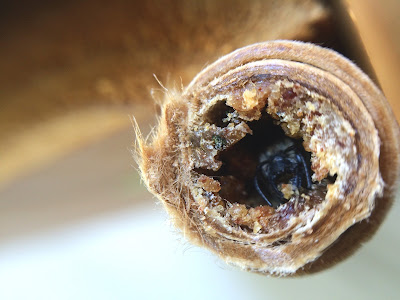Late last season I found an EZ Tear tube with an unusual plug. It wasn't mud so I knew it hadn't been filled by a Blue Orchard Bee. The plug was green but instead of leaf pieces, it looked like cooked spinach. It was quite sticky, so I assumed it was masticated leaves and resin. There's not a ton of leafcutter bee information on the Internet so I made a guess that after 3 weeks, the young bees inside would have spun their cocoons and I could open the tube to find out what was in there. Wrong! When I opened the tub I found a larva. Oh, I felt so bad! I rerolled the tube best I could, stuck the still intact green resin plug in, and stuffed the torn tube into another EZ Tear tube. I placed it back outside for another few weeks, then into hibernation it went for the winter and spring.
Leafcutter bees are active after Blue Orchard bees, so I put the tube out in early summer. For weeks nothing happened. Then I noticed a hole in the plug. Something had emerged! (Or maybe something dug in.)
 |
| The green plug aged to a brown color but remained quite sticky. |
I watched the tube for a while but saw no activity. Still curious to know what was inside, I opened it up again. There were remnants of many chambers, each separate from the next with apparently the same resinous material. Chamber after chamber was revealed as I unrolled the tube, ten or eleven in all.
 |
| Egg on pollen provision. |
Then I came to this, a freshly laid egg. Yipes! A quick share to
Instagram and the tube was rerolled (again), slipped back into the other EZ Tear tube and put back outside.
 |
| Leafcutters carry pollen on their bellies not in pollen baskets like a honeybee. Click on the photo to see an enlarged version for a better look at the yellow scopa on her abdomen. |
The second the tube was back in place, momma bee returned, buzzed me inquisitively for a moment then entered her tube. She continued to use the tube for several more days but I haven't seen her lately. I also can't see a plug. Either I spooked her off with my daily check, or the plug is recessed and difficult to see. Now I need to watch for monodontomerus wasps. They've been trying to get to the tubes previously plugged in the mason bee chalet, but can't get through a nylon stocking I put in their way.
 |
| Even though I stuffed the rerolled tub into a larger tube, I couldn't get it to slide all the way in. I used a knife to cut off the part sticking out, which explains the rough edges and fibers. |
 |
| She went to work right away, cleaning up the mess. |
 |
| August 14: Cap is still shiny even after a few days. |
I use a mix of tubes: the reeds purchased cocoons came in,
EZ Tear tubes and QuickLock trays. Regardless of the material, previously used tubes seem to be their preference.







2 comments:
I love the native bees that visit my yard, but I don't know that much about them, so this post was just fascinating. Love the photo of that egg!
I have my fingers crossed for that egg, @Julie D. Unlike a honeybee larva that is continually fed by its sisters, a solitary bee egg sits on all the food it's going to get. The pollen loaf is all it has to eat to take it from egg to complete adult. If it gets dislodged from its provision it can't move back and, silly me, I didn't pay attention to the orientation of the egg.
Post a Comment
Join the Conversation. Leave a comment.